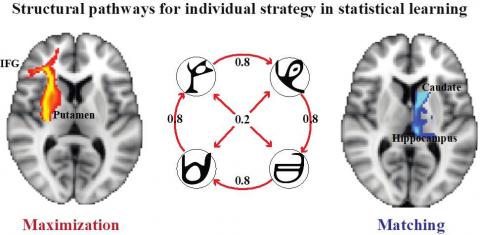Training is known to improve performance in a range of sensory-motor tasks and alter white-matter connectivity, as measured by Diffusion Tensor imaging (DTI).  Yet, learning to extract the statistics of event streams in natural environments is thought to often occur without explicit feedback (i.e. by mere exposure to the environment). Here, we demonstrate that this type of statistical learning of temporal structures without trial-by-trial feedback relates to changes in white-matter connectivity in the human brain. Our findings provide evidence for distinct cortico-striatal circuits that support individual ability to learn behaviorally-relevant statistics. In particular, individuals engage dissociable structural brain networks depending on their decision strategy, suggesting alternate brain routes to learning predictive structures.
Yet, learning to extract the statistics of event streams in natural environments is thought to often occur without explicit feedback (i.e. by mere exposure to the environment). Here, we demonstrate that this type of statistical learning of temporal structures without trial-by-trial feedback relates to changes in white-matter connectivity in the human brain. Our findings provide evidence for distinct cortico-striatal circuits that support individual ability to learn behaviorally-relevant statistics. In particular, individuals engage dissociable structural brain networks depending on their decision strategy, suggesting alternate brain routes to learning predictive structures.

